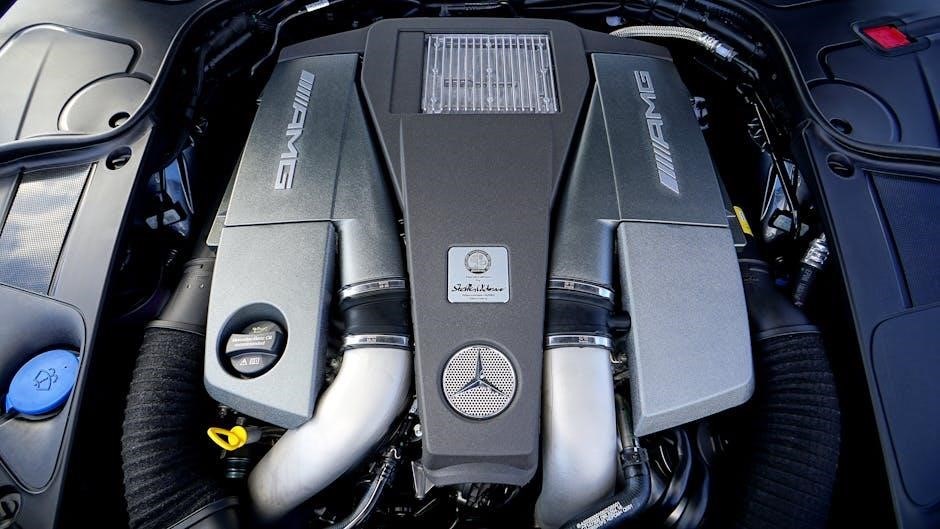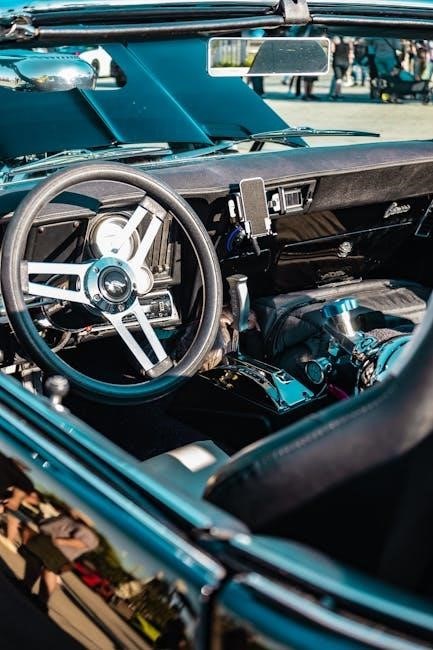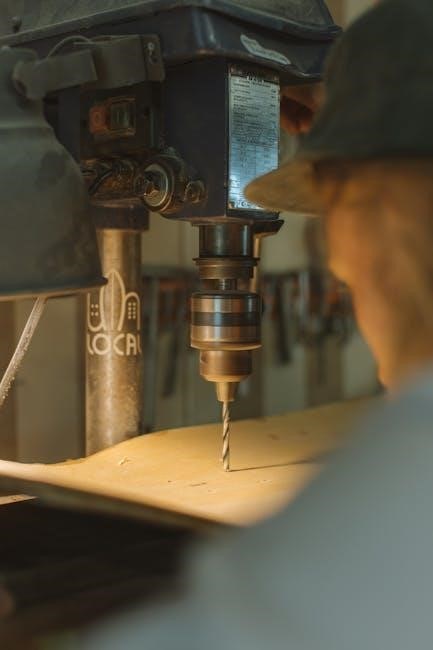3 speed gm manual transmission
The 3-speed GM manual transmission is a iconic component that has been a part of many General Motors vehicles, particularly from the 1930s to the 1970s. Known for its simplicity and durability, this transmission was widely used in various GM cars and trucks. It featured a column-mounted shifter in most cases, with a straightforward H-pattern gear selection. The 3-speed manual was praised for its ease of use and reliability, making it a favorite among drivers of the era. Over time, it has also become a popular choice for enthusiasts restoring or upgrading classic vehicles. Proper maintenance and identification of its components are essential for optimal performance.

History of the 3 Speed GM Manual Transmission
The 3-speed GM manual transmission has a rich and storied history that dates back to the early 20th century. First introduced in the 1930s, this transmission was designed to provide a simple yet effective way to transfer power from the engine to the wheels. It quickly became a staple in many General Motors vehicles, including Chevrolet cars and trucks, due to its reliability and ease of use. The transmission’s design was influenced by the need for a more driver-friendly alternative to the cumbersome manual transmissions of the time.
During the 1950s, the 3-speed manual transmission became a standard feature in many GM vehicles, particularly in the Chevrolet Bel Air and other popular models. This era saw the introduction of the column-mounted shifter, which became a defining characteristic of the 3-speed GM manual transmission. The shifter’s location on the steering column allowed for a more spacious interior and easier operation. The transmission’s popularity continued to grow throughout the 1960s, with its use extending to performance-oriented vehicles like the Chevrolet Corvette.
One of the most notable versions of the 3-speed GM manual transmission was the Muncie SM330 HD, which gained a reputation for its durability and performance capabilities. This particular model was often used in high-performance applications, including drag racing and hot rodding. The Muncie transmission’s strength and reliability made it a favorite among enthusiasts, and it remains sought after today for restoration projects and custom builds.
By the 1970s, the 3-speed manual transmission began to be phased out in favor of more modern designs, such as the 4-speed and 5-speed manuals, which offered better performance and fuel efficiency. However, the 3-speed GM manual transmission left an indelible mark on automotive history. Its simplicity, durability, and ease of use made it a beloved component for drivers and mechanics alike. Even today, the 3-speed GM manual transmission is celebrated by classic car enthusiasts and restorers who appreciate its timeless appeal and historical significance.

Design and Functionality
The 3-speed GM manual transmission was designed with simplicity and functionality in mind, making it both durable and easy to use. Its compact design allowed it to fit seamlessly into a variety of GM vehicles, from passenger cars to light trucks. The transmission featured a straightforward gear layout, with three forward speeds and one reverse gear, operated via a column-mounted shifter in most models. This design not only simplified the driving experience but also freed up space inside the vehicle, contributing to a more spacious interior.
The transmission’s functionality was rooted in its mechanical simplicity. It utilized a non-synchronized first gear in earlier models, which required drivers to double-clutch when shifting into first gear from a standstill. While this may seem less convenient by modern standards, it added to the transmission’s robustness and reduced production costs. The shift pattern followed the traditional H-pattern, with reverse gear typically located at the upper left position of the shifter. This layout became intuitive for drivers and remains a familiar feature of manual transmissions today.
One of the key design elements of the 3-speed GM manual transmission was its use of cast iron for the main casing. This material choice provided exceptional strength and durability, allowing the transmission to withstand the rigors of daily driving and even moderate performance use. The internal components, including the gears and bearings, were precision-engineered to ensure smooth and consistent operation. Over time, the transmission gained a reputation for being reliable and requiring minimal maintenance, making it a favorite among both everyday drivers and enthusiasts.
Despite its simplicity, the 3-speed GM manual transmission was adaptable to various driving conditions. It was available with different gear ratios, allowing drivers to choose a setup that best suited their needs. For example, a lower gear ratio could be selected for city driving, where frequent stopping and starting were common, while a higher ratio was better suited for highway use. This versatility made the transmission a practical choice for a wide range of vehicles and driving scenarios.
The design of the 3-speed GM manual transmission also played a significant role in its popularity among car enthusiasts. Its mechanical simplicity made it accessible to amateur mechanics and restorers, who could perform repairs and upgrades with basic tools. The availability of aftermarket parts and rebuild kits further enhanced its appeal, ensuring that these transmissions could be kept in good working condition for decades. This combination of durability, simplicity, and adaptability cemented the 3-speed GM manual transmission as a timeless classic in automotive history.

Key Components
The 3-speed GM manual transmission is comprised of several key components that work together to ensure smooth and efficient operation. These components are designed to withstand the rigors of daily driving while providing reliable performance. Understanding these parts is essential for appreciating how the transmission functions and for performing maintenance or repairs.

One of the most critical components of the 3-speed GM manual transmission is the gearset. This includes the three forward gears and one reverse gear, all of which are precision-engineered to provide smooth shifting and optimal torque transfer. The gears are typically made from high-strength steel to ensure durability and resistance to wear. The gear ratios are carefully designed to match the vehicle’s engine and drivetrain, ensuring efficient power delivery at various speeds.
The transmission bearings play a vital role in reducing friction and allowing the gears to rotate smoothly. These bearings are strategically located throughout the transmission, including on the input and output shafts. They are designed to handle the stresses of constant motion and varying loads, making them essential for the transmission’s longevity. Over time, these bearings may wear out, leading to noise or vibration, but they are relatively easy to replace during a rebuild.
The input shaft and output shaft are two of the most important mechanical components in the transmission. The input shaft connects to the clutch and engine, transmitting power into the transmission. The output shaft, on the other hand, sends power to the driveshaft and ultimately to the wheels. Both shafts are constructed from high-strength materials to withstand the stresses of torque transfer. Proper alignment and lubrication of these shafts are crucial for maintaining smooth operation.
The synchronizers are another key component in the 3-speed GM manual transmission. These devices are responsible for ensuring that the gears engage smoothly and quietly. The synchronizers use friction to match the speed of the gear being shifted into with the speed of the transmission, eliminating the need for double-clutching in later models. While the synchronizers are durable, they can wear out over time, leading to difficulty when shifting gears.
The transmission case serves as the housing for all the internal components. Made from cast iron or aluminum, the case is designed to be strong and durable, providing a solid foundation for the transmission’s operation. The case also includes mounting points for securing the transmission to the vehicle, ensuring stability and preventing movement under torque.
The seals and gaskets are essential for preventing fluid leaks and maintaining the transmission’s internal environment. These components are located at various points, including the input and output shafts, to ensure that the transmission fluid stays inside the case. Over time, these seals and gaskets may degrade, leading to leaks that can damage the transmission if left unchecked.

Types of 3 Speed GM Manual Transmissions
Over the years, General Motors (GM) has produced several types of 3-speed manual transmissions, each designed to meet specific vehicle requirements and performance needs. These transmissions were engineered to provide reliable service in a variety of applications, ranging from compact cars to larger sedans and even trucks. Understanding the different types of 3-speed GM manual transmissions can help enthusiasts and mechanics identify the correct unit for their vehicle and appreciate the engineering that went into these components.
One of the most well-known 3-speed manual transmissions produced by GM is the Saginaw 3-Speed. Named after the Saginaw Transmission Division, this transmission was widely used in GM vehicles during the 1960s and 1970s. The Saginaw 3-Speed was known for its durability and simplicity, making it a popular choice for many GM models, including Chevrolet and Pontiac vehicles. Its compact design and lightweight construction made it ideal for smaller cars, while its robust build allowed it to handle the power of larger engines.
Another notable type is the Borg-Warner T-10. Although Borg-Warner is not a division of GM, the T-10 transmission was used in many GM vehicles, particularly during the muscle car era of the late 1960s and early 1970s. The T-10 was known for its strength and ability to handle high-performance engines, making it a favorite among enthusiasts. However, it’s important to note that the T-10 is actually a 4-speed transmission, and its inclusion in GM vehicles was limited compared to other models.
The Muncie 3-Speed is another transmission that gained popularity in GM vehicles. Produced by the Muncie Transmission Division, this transmission was known for its reliability and smooth shifting characteristics. It was commonly used in Chevrolet and Buick models, particularly in the 1970s. The Muncie 3-Speed was also praised for its ease of maintenance, making it a favorite among DIY mechanics and restorers.
In addition to these, GM also produced the 3L30 and 3L40 transmissions, which were part of the “Long Tail” series. These transmissions were designed for use in rear-wheel-drive vehicles and featured a longer tailshaft housing to accommodate the driveshaft. The 3L30 and 3L40 were known for their durability and were often used in heavier-duty applications, such as trucks and larger sedans.
Lastly, the New Process Gear (NP) transmissions were another type of 3-speed manual transmission used by GM. These transmissions were known for their heavy-duty construction and were often used in trucks and other vehicles that required a more robust gearbox. The NP transmissions were praised for their ability to handle high torque and were a popular choice for drivers who needed a reliable transmission for hauling or towing.

Maintenance and Care
Proper maintenance and care are essential to ensure the longevity and smooth operation of a 3-speed GM manual transmission. Regular upkeep not only prevents costly repairs but also enhances the overall driving experience. By following a routine maintenance schedule, owners can identify potential issues early and address them before they escalate.
Transmission Fluid Checks: The transmission fluid plays a crucial role in lubricating the gears and cooling the system. It is recommended to check the fluid level regularly, typically every 5,000 to 7,500 miles, using the dipstick provided. The fluid should be clean and free from debris. If the fluid is dirty or low, it should be replaced immediately. Always use the type of transmission fluid specified by GM to ensure compatibility and optimal performance.
Clutch Maintenance: The clutch is an integral part of the manual transmission system. Worn-out or misaligned clutch components can lead to poor shifting and increased wear on the transmission. Signs of clutch wear include slipping, difficulty shifting gears, or a spongy pedal feel. It is essential to inspect the clutch periodically and replace worn components as needed. Proper clutch maintenance ensures smooth engagement and disengagement of gears, reducing strain on the transmission.
Inspecting Gear Lubricant: In addition to transmission fluid, the gears in a 3-speed GM manual transmission require proper lubrication to function smoothly. High-quality gear lubricant should be applied to the gears at regular intervals, typically every 15,000 to 30,000 miles. This helps reduce friction and prevents premature wear on the gear teeth. Always refer to the GM service manual for the correct type and amount of lubricant to use.

Driveshaft and Axle Inspection: The driveshaft and axles are directly connected to the transmission and play a vital role in transferring power to the wheels. Over time, these components can develop wear or damage, which can affect transmission performance. It is important to inspect the driveshaft and axles periodically for signs of wear, such as cracks or excessive play. Addressing these issues promptly can prevent costly repairs and ensure smooth power delivery.
Replacing Filters: Some 3-speed GM manual transmissions are equipped with a filter to keep the transmission fluid clean. If your transmission has a filter, it should be replaced every 30,000 to 60,000 miles, depending on usage. A dirty or clogged filter can restrict fluid flow, leading to overheating and premature wear on transmission components. Always use a high-quality filter that meets GM specifications.
Checking Seals and Gaskets: Leaks are a common issue in older transmissions, and they can lead to serious problems if left unchecked. Regularly inspect the seals and gaskets around the transmission pan, input shaft, and other connections for signs of wear or damage. If a leak is detected, replace the affected seal or gasket immediately to prevent fluid loss and contamination.
Inspecting Shifting Mechanisms: The shifting mechanisms, including the gearshift linkage and synchronizers, should be inspected periodically for wear or misalignment. Worn-out synchronizers can cause difficulty shifting gears, while misaligned linkages can lead to inaccurate gear engagement. Adjusting or replacing these components as needed ensures smooth and precise shifting.
Transmission Pan Gasket: The transmission pan gasket is another critical component that requires regular attention. Over time, the gasket can become brittle or cracked, leading to leaks. Inspecting and replacing the gasket every 5,000 to 10,000 miles can help prevent these issues. Always use a high-quality gasket that meets GM specifications for a proper seal.

Installation and Swapping
Installing or swapping a 3-speed GM manual transmission is a complex process that requires careful preparation and execution. Whether you’re upgrading your vehicle’s performance or replacing a faulty transmission, the installation process must be approached with precision to ensure proper functionality and safety. Below is a detailed guide to help you through the installation and swapping process.
Preparation
Before starting the installation, ensure you have all the necessary tools and materials. Essential tools include a transmission jack, wrenches, sockets, and jack stands. Additionally, gather new components such as gaskets, seals, and transmission fluid. Consult the GM service manual for specific instructions tailored to your vehicle’s make and model.
Removing the Old Transmission
Begin by disconnecting the negative terminal of the car battery to prevent any electrical hazards. Next, lift the car using jack stands to access the underside. Remove the driveshaft and any electrical connectors attached to the transmission. Disconnect the clutch and gearshift linkage, taking care not to damage these components. Finally, unbolt the transmission from the engine and carefully lower it using the transmission jack.
Installing the New Transmission
Mount the new transmission to the transmission jack and align it with the engine. Ensure proper alignment with the engine and chassis, securing it with bolts. Reconnect the driveshaft, clutch, and gearshift linkage, making sure all connections are tight and properly aligned. Replace any worn-out components such as the clutch or seals to ensure optimal performance.
Post-Installation Checks
After installation, refill the transmission with the recommended fluid type and check for any leaks around the seals and gaskets. Reconnect the battery and start the engine to test the transmission’s operation. Take the car for a test drive to ensure smooth shifting and proper gear engagement. Listen for any unusual noises or vibrations that may indicate issues.
Tips and Precautions
Ensure compatibility of the new transmission with your vehicle’s specifications to avoid installation issues. Use a transmission jack to safely handle the weight of the transmission, and always refer to the service manual for specific instructions. Proper alignment and secure connections are crucial for the transmission’s performance and longevity. If unsure about any step, consider consulting a professional mechanic.
By following these steps and taking necessary precautions, you can successfully install or swap a 3-speed GM manual transmission, ensuring your vehicle operates smoothly and efficiently.

Troubleshooting Common Issues
Troubleshooting common issues with the 3-speed GM manual transmission is essential for maintaining its performance and longevity. While these transmissions are known for their durability, they are not immune to problems that can arise from wear and tear, improper maintenance, or installation errors. Below, we explore some of the most common issues and how to address them.
Difficulty Shifting Gears
One of the most frequent issues is difficulty shifting gears, often accompanied by a grinding sensation. This can be caused by low transmission fluid levels, worn-out synchronizers, or misaligned gear linkages. To resolve this, check the transmission fluid level and top it off if necessary. If the problem persists, inspect the synchronizers and replace them if they show signs of wear. Additionally, ensure the gearshift linkage is properly adjusted and lubricated.
Grinding or Noisy Operation
Noises such as grinding, whining, or clunking during operation can indicate worn bearings, damaged gears, or improper gear engagement. Inspect the bearings and gears for excessive wear or damage. If the noise is persistent, it may be necessary to replace the faulty components. Proper gear engagement can also be achieved by adjusting the clutch pedal and ensuring it is not riding excessively.
Leaks
Fluid leaks are another common issue, often resulting from worn-out seals or gaskets. Inspect the transmission pan, input shaft, and output shaft for signs of leakage. Replace any damaged seals or gaskets and ensure all connections are tightened properly. Regularly checking the transmission fluid level can help identify leaks early on.
Slipping or hesitation Between Gears
Slipping or hesitation between gears can be caused by worn-out clutch packs or improper transmission fluid pressure. Inspect the clutch packs and replace them if they are worn or damaged. Additionally, check the transmission fluid pressure and adjust it according to the manufacturer’s specifications. If the issue persists, it may be necessary to replace the entire clutch assembly.
Overheating
Overheating can occur due to excessive load, insufficient cooling, or clogged fluid passages. Monitor the transmission temperature gauge and ensure proper airflow around the transmission. Clean or replace any clogged fluid passages and consider upgrading to a high-capacity transmission cooler if necessary. Avoid operating the vehicle under extreme conditions until the issue is resolved.
Gear Engagement Problems
Gear engagement problems, such as gears not engaging fully or popping out of gear, can be caused by worn-out detent springs or misaligned gear linkages. Inspect the detent springs and replace them if they are worn. Adjust the gearshift linkage to ensure proper alignment and engagement. If the problem persists, it may be necessary to replace the entire gear assembly.
Bearing Noise
Bearing noise, often described as a humming or growling sound, can indicate worn-out or damaged bearings. Inspect the bearings and replace them if necessary. Proper lubrication and alignment can also help reduce bearing noise. If the noise is severe, it may be necessary to replace the entire transmission.
Troubleshooting common issues with the 3-speed GM manual transmission requires a systematic approach and basic tools. By identifying the root cause of the problem and addressing it promptly, you can extend the life of your transmission and ensure smooth operation. Regular maintenance and inspections can help prevent many of these issues from arising in the first place. If you are unsure about any aspect of the troubleshooting process, consult a professional mechanic for assistance.
One of the key strengths of the 3-speed GM manual transmission is its straightforward design, which simplifies maintenance and repairs. Unlike modern transmissions with complex electronics and multiple gears, this unit emphasizes mechanical simplicity, making it accessible to those who enjoy working on their own vehicles. Its robust construction ensures that, with proper care, it can last for decades without major overhauls.
However, it’s important to acknowledge that the 3-speed GM manual transmission does have limitations. Its lack of modern features, such as overdrive or advanced gear ratios, may make it less suitable for high-speed cruising or fuel efficiency in contemporary vehicles. Nevertheless, its charm lies in its nostalgic appeal and the driving experience it provides, which many enthusiasts find irreplaceable.
The availability of parts and a strong support community further enhance the appeal of this transmission. Whether you’re restoring a classic Chevrolet or swapping it into a custom project, the 3-speed GM manual transmission remains a practical and cost-effective choice. Its widespread use across multiple GM models ensures that resources, both in terms of parts and knowledge, are readily accessible.











Leave a Comment